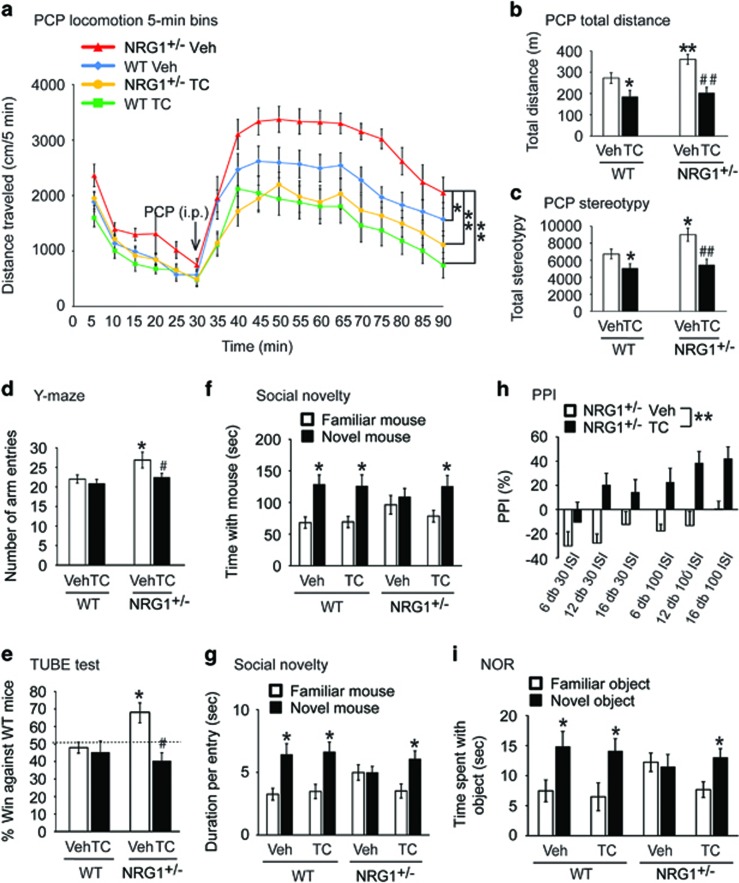Figure 4.
STEP inhibition reverses behavioral and cognitive deficits in Nrg1+/− mice. Male wild-type (WT) and Nrg1+/− littermates (6–9 months old, 9–16 male mice each group) were used for all tests. (a–c) Pharmacological inhibition of STEP61 normalizes phencyclidine (PCP)-induced hyperlocomotor activity and stereotypies. Mice were administered TC-2153 (TC, 10 mg kg−1, intraperitoneally (i.p.)) or vehicle (Veh) and monitored for basal activities for 30 min. Mice were then challenged with PCP (7.5 mg kg−1, i.p.) for 1 h. Distance traveled in each 5 min bin during the 90 min test period (a), total distance traveled (b) and total stereotypic counts (c) were recorded and analyzed using Activity Monitor (MED Associates). (d) Nrg1+/− mice made more entries in Y-maze; this was reversed 3 h after TC-2153 treatment. (e) TC-2153 administration normalizes aggressive behavior in Nrg1+/− mice. Mice were administered TC-2153 (TC, 10 mg kg−1, i.p.) or Veh. Three hours after injection, mice were tested in a narrow plastic tube against non-littermate naive WT mice. Each mouse went through four trials and percentage of win was plotted. (f, g) TC-2153 administration improves social behavior in the social novelty task in Nrg1+/− mice. Mice were administered TC-2153 (TC, 10 mg kg−1, i.p.) or Veh. Three hours after injection, mice were tested in three-chamber social task. Behaviors in the first two stages (habituation and social preference) are shown in Supplementary Figure S10. (h) TC-2153 treatment reversed prepulse inhibition (PPI) deficits in Nrg1+/− mice. Nrg1+/− mice were treated with TC or Veh 3 h prior to PPI test. (i) TC-2153 reverses cognitive deficits in Nrg1+/− mice in the novel object recognition (NOR) task. Mice were administered TC-2153 (TC, 10 mg kg−1, i.p.) or Veh. Three hours after injection, mice were trained with two identical objects. Twenty-four hours after training; mice were tested in the choice phase with one familiar object and one novel object. All data are expressed as mean±s.e.m. and statistical significance was determined using two-way analysis of variance (ANOVA) with repeated-measures (RM) followed by post-hoc Bonferroni’s test for panel (a) or two-way ANOVA with post-hoc Bonferroni’s test for panels (b–d) or RM-ANOVA for panel (h) or chi-square one-sample t-test against 50% chance for panel (e) or Student’s t-test comparing two objects for panels (f, g, i) (*P<0.05, **P<0.01, compared with the WT Veh group; #P<0.05, ##P<0.01 compared with Nrg1+/− Veh group, n=9–16 per group).

